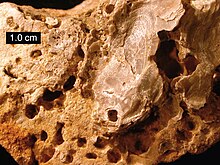Terra dura carbonatada

Les terres dures carbonatades, en anglès: Carbonate hardgrounds, són superfícies de capes de carbonats sedimentàriament cimentades que ha estat exposades en el llit marí (Wilson and Palmer, 1992). Per tant una terra dura carbonatada és essencialment un llit marí litificat. Es poden veure antigues terres dures en les seqüències de pedra calcària (especialment bryozoa, ostres, percebes, cornulítids, hederellidae i crinoïdeus), forats d'organismes marins produïts a través de la bioerosió, ciments de calcita marins o extenses superfícies mineralitzades per òxids de ferro o fosfat de calci (Palmer, 1982; Bodenbender et al., 1989). Les terres dures modernes normalment es detecten pel sonar en aigües somes o per tècniques com el radar.
Les terres dures carbonatades sovint hostatgen una fauna única i una flora adaptada a la superfície dura. Els organismes normalment es cimenten entre ells i s'alimenten per filtració (Brett and Liddell, 1982).
La majoria de les terres dures carbonatades es van formar durant els intervals del Mar de Calcita Els períodes Ordovicià-Silurià i el Juràssic-Cretaci tenen la majoria de les terres dures.
En l'estratigrafia i la sedimentologia sovint es fan servir les terres dures com indicadores de hiatus sedimentaris o esdeveniments d'inundació (Fürsich et al., 1981, 1992; Pope and Read, 1997).
Referències[modifica]
- Bodenbender, B.E., Wilson, M.A., Palmer, T.J. «Paleoecology of Sphenothallus on an Upper Ordovician hardground». Lethaia, 22, 2, 1989, pàg. 217–225. DOI: 10.1111/j.1502-3931.1989.tb01685.x.
- Brett, C.E., Liddell, W.D. «Preservation and paleoecology of a Middle Ordovician hardground community». Paleobiology, 4, 1981, pàg. 329–348.
- Fürsich F.T., Kennedy, W.J., Palmer, T.J. «Trace fossils at a regional discontinuity surface: the Austin/Taylor (Upper Cretaceous) contact in central Texas». Journal of Paleontology, 55, 1981, pàg. 537–551.
- Fürsich, F.T., Oschmann, W., Singh, B., Jaitly, A.K. «Hardgrounds, reworked concretion levels and condensed horizons in the Jurassic of western India: their significance for basin analysis». Journal of the Geological Society of London, 149, 3, 1992, pàg. 313–331. DOI: 10.1144/gsjgs.149.3.0313.
- Malpas, J.A., Gawthorpe, R. L., Pollard, J.E., Sharp, I.R. «Ichnofabric analysis of the shallow marine Nukhul Formation (Miocene), Suez Rift, Egypt: implications for depositional processes and sequence stratigraphic evolution». Palaeogeography, Palaeoclimatology, Palaeoecology, 215, 3–4, 2004, pàg. 239–264. DOI: 10.1016/j.palaeo.2004.09.007.
- Palmer, T.J. Fürsich, F.T. «The ecology of a Middle Jurassic hardground and crevice fauna». Palaeontology, 17, 1974, pàg. 507–524.
- Palmer, T.J., Palmer, C.D. «Faunal distribution and colonization strategy in a Middle Ordovician hardground community». Lethaia, 10, 3, 1977, pàg. 179–199. DOI: 10.1111/j.1502-3931.1977.tb00608.x.
- Palmer, T.J., Wilson, M.A. «Calcite precipitation and dissolution of biogenic aragonite in shallow Ordovician calcite seas». Lethaia, 37, 4, 2004, pàg. 417–427[1]. DOI: 10.1080/00241160410002135.
- Palmer, T.J. «Burrows at certain omission surfaces in the Middle Ordovician of the Upper Mississippi Valley». Journal of Paleontology, 52, 1978, pàg. 109–117.
- Palmer, T.J. «Cambrian to Cretaceous changes in hardground communities». Lethaia, 15, 4, 1982, pàg. 309–323. DOI: 10.1111/j.1502-3931.1982.tb01696.x.
- Pope, M.C., Read, J.F. «High-resolution surface and subsurface sequence stratigraphy of the Middle to Late Ordovician (late Mohawkian-Cincinnatian) foreland basin rocks, Kentucky and Virginia». AAPG Bulletin, 81, 1997, pàg. 1866–1893.
- Taylor, P.D., Wilson, M.A. «Palaeoecology and evolution of marine hard substrate communities». Earth-Science Reviews, 62, 2003, pàg. 1–103[2]. DOI: 10.1016/S0012-8252(02)00131-9.
- Wilson, M.A., Palmer, T.J. «Hardgrounds and hardground faunas». University of Wales, Aberystwyth, Institute of Earth Studies Publications, 9, 1992, pàg. 1–131.
- Wilson, M.A., Wolfe, K.R., Avni, Y. «Development of a Jurassic rocky shore complex (Zohar Formation, Makhtesh Qatan, southern Israel)». Israel Journal of Earth Sciences, 54, 3, 2005, pàg. 171–178[3]. DOI: 10.1560/71EQ-CNDF-K3MQ-XYTA.
